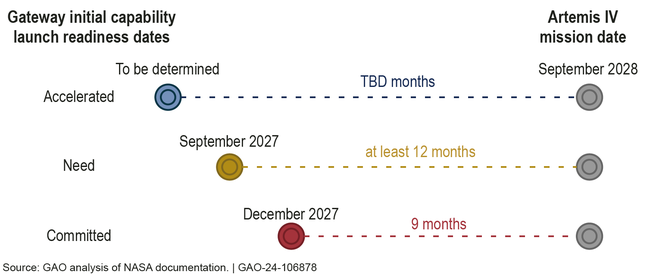Artemis Programs: NASA Should Document and Communicate Plans to Address Gateway's Mass Risk
Fast Facts
Two pieces of NASA's Gateway program—the first space station to orbit the moon—are scheduled to launch together in 2027. NASA is taking steps to ensure Gateway will be ready. For example, the program plans to update a cost and schedule analysis that will help determine whether the launch date is feasible.
But this program also faces some significant challenges. For example, the mass of the pieces is too high. So, if it isn't reduced, they might not be able to reach the correct lunar orbit once launched.
We recommended documenting the Gateway program's plans to address this issue to help ensure it can meet the planned launch date.
Artist Rendering of the Gateway

Highlights
What GAO Found
The National Aeronautics and Space Administration (NASA) plans to build a sustained human lunar presence and ultimately travel to Mars through a series of missions known as Artemis. For Artemis IV, the agency is developing the Gateway—the first space station planned to orbit the moon. NASA committed to launching the Gateway initial capability by December 2027 at a cost of $5.3 billion. The launch will include the first components of the Gateway—the Power and Propulsion Element (PPE) and the Habitation and Logistics Outpost (HALO).
The Gateway program plans to update the analysis it used to inform its cost and schedule commitments at a fall 2024 program-level review. This will help determine the feasibility of the Artemis IV mission date. To reach lunar orbit and ensure all systems work as planned, the PPE and HALO need to launch at least 12 months before the Artemis IV mission, or 3 months earlier than Gateway's current committed date. NASA officials said the program plans to work to an accelerated, to-be-determined date that would provide more schedule flexibility.
Gateway Program Launch Date Options for Artemis IV Mission

The Gateway program's projects—including PPE and HALO—made varying degrees of progress over the last year. However, the PPE and HALO projects face several significant challenges. For example, their combined mass is greater than their mass target. Mass is one of many factors that the program considers in its overall design. If they cannot meet their mass target, it may affect their ability to reach the correct lunar orbit. The program has not yet documented an overall mass management plan, which would describe the program's mass reduction approach and priorities for key trade-off decisions. Documenting and communicating this plan will help to ensure that the program and its projects agree on how to address the mass challenge.
NASA held two reviews in 2023 to break down high-level Artemis exploration objectives and goals into the programs, projects, or systems needed to achieve them. So far, NASA has used these reviews to assign roles to the Gateway that align to goals of the earlier Artemis missions, like returning humans to the moon. NASA plans to use upcoming reviews to make key decisions related to Mars missions, which could inform how NASA might use the Gateway in the future.
Why GAO Did This Study
NASA plans to return astronauts to the moon to make new scientific discoveries, generate economic benefits, and inspire a new generation. To help support crewed lunar landings, NASA plans to use the Gateway as a habitat and safe work environment for astronauts. NASA plans to first use the Gateway to house crew during the Artemis IV lunar landing mission, which NASA is planning to conduct in September 2028. NASA tracks the Gateway program's progress via cost and schedule commitments.
A House Report contains a provision for GAO to continue reviewing NASA's lunar-focused programs. This report focuses on the Gateway program and its NASA-led development projects. It addresses (1) the Gateway program's plans to update the initial capability's cost and schedule analysis; (2) the extent to which the Gateway program made progress with its U.S.-led projects needed for the Artemis IV mission and is addressing project risks; and (3) NASA's process for determining how it will use the Gateway beyond Artemis IV, including for Mars missions.
GAO analyzed NASA documentation and interviewed officials on the Gateway program's cost, schedule, risks, and role in the Artemis architecture.
Recommendations
GAO is making one recommendation, that NASA should ensure that the Gateway program documents and communicates an overall mass management plan before its next program-level review. NASA agreed with GAO's recommendation.
Recommendations for Executive Action
| Agency Affected | Recommendation | Status |
|---|---|---|
| National Aeronautics and Space Administration | The NASA Administrator, in coordination with the Exploration Systems Development Mission Directorate, should ensure that the Gateway program documents its overall mass management plan and shares it with its projects ahead of the program's planned September 2024 critical design-informed synchronization review. (Recommendation 1) |
NASA concurred with our recommendation. In spring 2025, the Gateway program and HALO project approved the Gateway Configuration 1 (CMV) Transit Margin and Reserves Strategy. The strategy describes how the program will make decisions related to managing spacecraft mass, spacecraft power, and flight time margin and reserves across the program. NASA documents indicate that a preliminary version of this document was in use prior to and during the Gateway program's Critical Design Review - Informed Synchronization Review, which began in September 2024 and concluded in April 2025. These actions met the intent of our recommendation.
|
